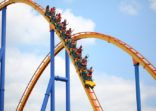FE data shows that the top two performing mixed-asset funds over the trailing three years are China focused, yet the BNY Mellon Global Real Return Fund, a peer product, has not taken direct China investments.
“We don’t have significant exposure to Chinese assets as such,” Pataki, co-manager of the fund and global portfolio manager at BNY Mellon affiliate Newton Investment, told FSA.
“But we do have indirect exposure to growth and consumption in China through healthcare companies that are listed in developed markets, but get a substantial portion of their revenues in Asia, including China.”
His main concern is the alarming level of China’s debt problem, estimated at $3-$6trn, depending on whether shadow banking is included.
“Ultimately we think that China has to [first] deflate its credit bubble.”
Volatility factor
The mixed-asset fund aims to provide a minimum return of the cash benchmark (1 month USD Libor) + 4% per annum over five years before fees, which are 1.5% annually for the A share class.
The portfolio seeks to generate long-term returns and ensure capital preservation, he said.
Top ten holdings are mainly conservative assets. The biggest position is in US treasuries due in 2048, which account for 10% of the portfolio.
Volatility is particularly low. Out of 46 funds in the category, the BNY product had the third lowest three-year annualised volatility (4.5%), FE data shows.
In terms of performance, the top in the category – Fidelity’s Greater China Multi Asset Growth & Income – had an annualised three-year return of 10.52%, far outperforming the 2.27% of the BNY fund.
But annualised volatility for the former was higher (10.5%) vs the latter (4.5%) and the category average (6.4%).
In challenging environments, such as last year, Pataki said he shifts emphasis to capital preservation.
In volatile Q4 2018, the fund returned -1.49% against the mixed asset category average of -5.94% (chart below).
He explained that in the fourth quarter, he decided to de-risk the portfolio substantially, which helped the fund produce a positive return for full year 2018 (FE data shows 0.31% vs -8.8% category average).
“We took out some cyclicality in the equity portfolio, in sectors such as industrial, financial or others that potentially can display higher volatility in a turbulent environment.
Net equity weight was also reduced in the fund by 5% by trimming the cyclical sector exposure, Pataki said. Therefore, the portfolio at the beginning of Q4 2018 had a net equity weight of 40%, which fell to about 20% by the end of the year, he said.
He also increased the bond duration in the portfolio in the fourth quarter, as “yield levels in the US drifted up”, which allowed them “to increase duration at an attractive yield level.
“We first established a large position in ten-year treasuries, including bonds in Australia, Canada and New Zealand.”
Gold exposure was increased, partly because of the metal’s negative correlation with real interest rates, he said.
Inflation risk
At the end of April 2019, portfolio return-seeking assets were 60.6% and “stabilising assets & hedging positions” accounted for 39.4%. He admits caution due to the “potentially toxic combination of deteriorating fundamentals and lofty valuations.
“The strategy can dial up the risk when valuations and risk/reward are more favourable.”
For example, in the aftermath of the 2001 technology bust, he said that the size of return-seeking assets reached as high as 85% in 2004-2005 “in order to take advantage of many opportunities and harness the upswing.
“Another example was in 2009 when we increased the weighting in corporate bonds as spreads blew out indiscriminately across the sector.”
Pataki said the biggest risk to his investment thesis in the next 12 months, which he believes has a low probability, is rising interest rates.
“If real interest rates rise materially, then the portfolio could underperform in the current positioning.
“This defensive positioning could be at risk if global growth picks up substantially.”
The BNY Global Real Return Fund vs the category, 3 years

In Q4 2018


















